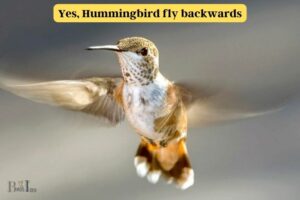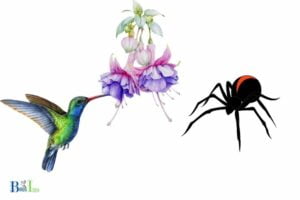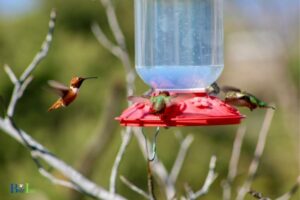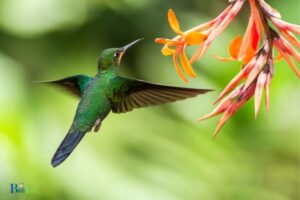Are There Hummingbirds in Australia: No, Explore!
No, there are no hummingbirds in Australia.
This is because hummingbirds are found exclusively in the Americas, from Southern Canada down to the southernmost tip of South America.
While hummingbirds are primarily found in the Americas, Australia has its own equivalent in the form of nectar-feeding birds.
Rainbow Lorikeets and Honeyeaters, for example, share many of the behaviors associated with hummingbirds, such as hovering near flowers and feeding on nectar.
Due to this continent-specific distribution, hummingbirds cannot be found in Australia.
Four facts about hummingbirds:
Hummingbirds have evolved a unique set of adaptations that have allowed them to become successful in the Americas.
This includes the ability to hover in place and quickly agility in the air, enabling them to take advantages of the many different sources of nectar spread across the region.
However, these adaptations are not found in Australia, leading to the absence of hummingbirds throughout the continent.
4 Questions of Hummingbirds in Australia
| Question | Answer |
|---|---|
| Are there hummingbirds in Australia? | No, there are no native hummingbirds in Australia. |
| What is the closest bird species to a hummingbird in Australia? | The closest bird species to a hummingbird in Australia is the sunbird, which is found in the northern parts of the country. |
| Are there any introduced hummingbird species in Australia? | No, there are no introduced hummingbird species in Australia as it is illegal to import any non-native bird species. |
| Why aren’t there hummingbirds in Australia? | Hummingbirds are native to the Americas, and they have not evolved to live in other parts of the world. The climate and plant life in Australia are also not suitable for hummingbirds. |
Key Takeaway
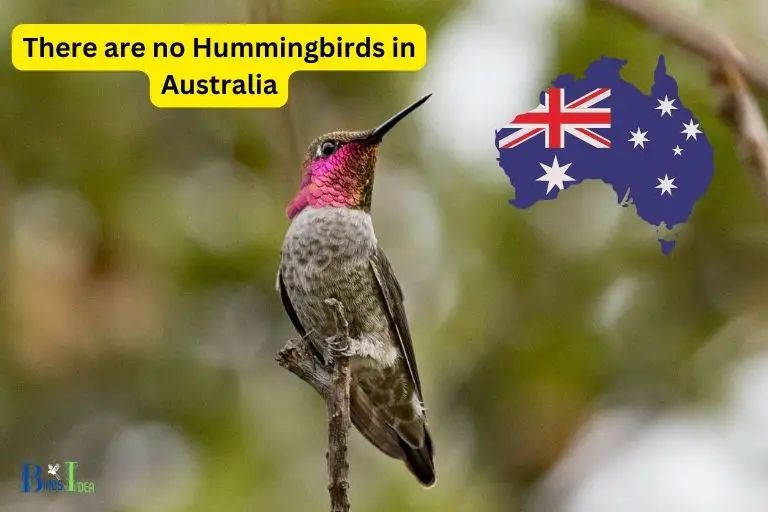
Five Facts About: Presence of Hummingbirds in Australia
DID YOU KNOW
Over 350 species of hummingbirds have been recognized across the Americas.
Overview of Hummingbirds: Features
Hummingbirds are some of the smallest and most fascinating birds in the world. They are found in the Americas and have unique characteristics that make them stand out from other birds.
Hummingbirds are characterized by their small size, iridescent feathers and long, thin beaks. Their wings beat so fast that they can hover in mid-air and even fly backwards.
They can also dive and hover in one spot for a few seconds.

Hummingbirds feed mainly on nectar and insects, but can also eat small fruits and spiders. They feed from flowers, trees, and feeders and can consume up to 8 times their body weight in a day.
Hummingbirds also have highly efficient metabolisms, allowing them to survive on a diet of mainly sugar. They have a lifespan of up to 12 years and reproduce in the spring or summer.
Features of Hummingbirds:
- Small size
- Iridescent feathers
- Long, thin beak
- Ability to hover and fly backwards
- Diet of nectar, insects, and small fruits
- Highly efficient metabolism
- Lifespan of up to 12 years
Distinctive Adaptive Features of Hummingbirds
Hummingbirds are small, agile birds with unique adaptations that make them well-suited to their environment.
These adaptive features enable hummingbirds to not only survive but also thrive in their habitats.

Here are some of the distinctive adaptive features of hummingbirds:
Highly specialized bill:
Hummingbirds have a long, curved bill that has evolved to suit the nectar-feeding behavior of the species. The bill enables them to reach into deep flower tubes and extract nectar quickly and efficiently.
High Metabolism:
Hummingbirds have a high metabolic rate to match their high energy demands. This metabolic rate enables them to take in more energy than other birds, allowing them to power their wings and hover in midair.
Rapid Flight:
Hummingbirds have evolved to be the fastest-flying birds. They can reach speeds up to 30 miles per hour and can even beat their wings up to 80 times per second.
Hovering:
Hummingbirds are the only birds that are capable of hovering in midair. To do this, they use their wings to create a powerful downstroke and an upstroke to direct air downward and keep themselves in the air.
Camouflage:
Hummingbirds also have feathers that can change color, helping them to blend into the surroundings and remain undetected by potential predators.
These are some of the distinctive adaptive features of hummingbirds that make them well-suited to their environment.
“Hummingbirds are a unique and beautiful species, they are only found in the Americas and cannot be found in Australia.”
birdsidea
Why Are Hummingbirds Not Found In Australia?
Hummingbirds are some of the most fascinating and beautiful birds in the world. They are also found in many parts of the world, but not in Australia.
This is due to several reasons:

- Hummingbirds are native to the Americas and are not found naturally in any other part of the world.
- The climate in Australia is not suitable for the species to colonize.
- The absence of a suitable food supply in Australia is another major reason why hummingbirds cannot survive there.
- There is also a lack of suitable nesting sites, which is essential for the species to survive in a new place.
Overall, the combination of unsuitable climate, lack of food and nesting sites means that hummingbirds cannot survive in Australia. As a result, the only way for Australians to see a hummingbird is to travel to the Americas.
How Have Hummingbirds Adapted to Their Environment?
Hummingbirds are incredibly adaptable and have evolved to live in a variety of environments.
Here are a few of the ways that hummingbirds have adapted to their environment:

Flight:
Hummingbirds have evolved to be able to fly at incredibly high speeds and maneuver with great precision. This is advantageous because they can easily evade predators and find food sources.
Size:
Hummingbirds are very tiny, which makes them hard to spot and catch. It also makes them very light, enabling them to fly farther and faster.
Beaks:
Hummingbirds have long, curved beaks that are perfect for reaching into flowers and collecting nectar.
Metabolism:
Hummingbirds also have an extremely high metabolism, which allows them to quickly digest food and convert it into energy. This helps them to stay active and find food sources.
Hummingbirds are remarkable creatures that have adapted to their environment in many ways. Their impressive flight abilities, tiny size, specialized beaks, and high metabolism enable them to survive in the wild.
Are Hummingbirds Threatened?
Hummingbirds are one of the most beloved birds in the world and are currently not threatened. However, as with many other species, there are numerous factors that can negatively affect them.

Loss of Habitat:
Hummingbirds rely on specific habitats for their food sources, nesting and shelter. Human activity, such as land development and logging, can drastically reduce the amount of natural habitat available to them.
Climate Change:
Climate change can reduce the availability of nectar and other food sources, as well as nesting areas.
Pesticides:
Pesticides and other chemicals used in agricultural areas can reduce the total number of hummingbirds.
Predators:
Predators such as cats, snakes and birds of prey can have a major impact on hummingbird populations.
Overall, hummingbirds are not currently threatened, but there are many factors that could cause their population to decline.
It is important to take steps to protect their habitats and food sources, as well as to be aware of the dangers of climate change, pesticides and predators.
How to Attract Hummingbirds to Gardens?
Hummingbirds are beautiful and vibrant creatures that are known to brighten any garden they visit.

Attracting them to your garden can be done with a few simple steps.
Provide Nectar:
The most important factor in attracting hummingbirds is to provide them with a reliable source of nectar.
Planting flowers that are known to attract them, such as trumpet creeper, coral honeysuckle, and jewelweed, is a great way to attract hummingbirds to your garden.
Additionally, provide a feeder filled with a sugar-water solution—four parts water, one part sugar—for them to feed on.
Add Color:
Hummingbirds are attracted to bright colors, so adding brightly-colored flowers to your garden can be beneficial.
Planting a variety of flowers of different colors and shapes, such as pansies, petunias, and morning glories, will add visual interest to your garden and appeal to hummingbirds.
Provide Shelter:
Hummingbirds need a place to perch, rest, and take refuge from animals. Plant a flowering shrub, such as a butterfly bush, to provide a place for them to land and hide.
Additionally, adding a bird bath to your garden is a great way to provide a place for them to take a break and cool off.
By following these steps, you can create an inviting environment for hummingbirds in your garden that will keep them coming back.
Interesting Facts About Hummingbirds
Hummingbirds are tiny birds with fascinating characteristics.
Here are five interesting facts about them:

- They are the smallest bird species in the world, ranging in size from 2-8 inches.
- They are the only bird species that can fly backwards.
- Their wings flap up to 80 times per second, producing a humming sound.
- Hummingbirds are the only bird species that can hover in mid-air while they feed on nectar from flowers.
- They can migrate over long distances, flying up to 500 miles in a single night.
Hummingbirds have captivated people for centuries with their remarkable aerial acrobatics. They are known for their beautiful feathers, vibrant colors, and unique ability to fly in any direction.
With their tiny size, their incredible flight capabilities, and their remarkable stamina, hummingbirds are truly one of nature’s most incredible creatures.
FAQ of Are There Hummingbirds In Australia
Are there Hummingbirds in Australia?
What is the best way to keep squirrels from accessing a hummingbird feeder?
Adding an adjustable rope or wire hanger between the support pole and the feeder can also help keep them away, as a squirrel will have to push and pull to get the feeder close enough to reach it.
Do squirrels harm hummingbirds?
Additionally, squirrels have a tendency to chew on plastic feeders, which can limit the life of the feeder.
How do I choose a hummingbird feeder that is squirrel proof?
Conclusion
Hummingbirds are an iconic species found exclusively in the Americas.
However, despite the wide range of these birds, they are not present in Australia due to its unique geographical placement.
Therefore, it is a fact that there are no hummingbirds in Australia.

